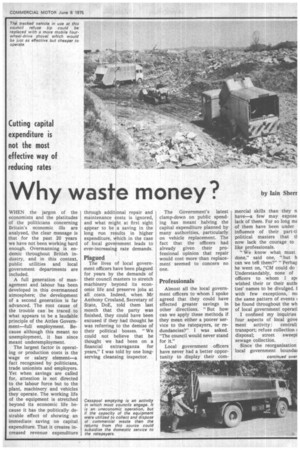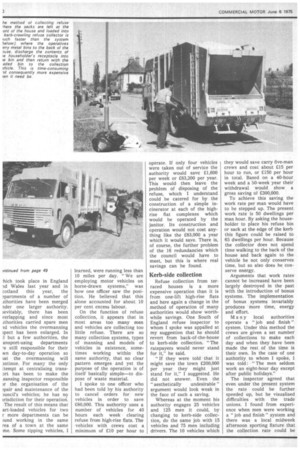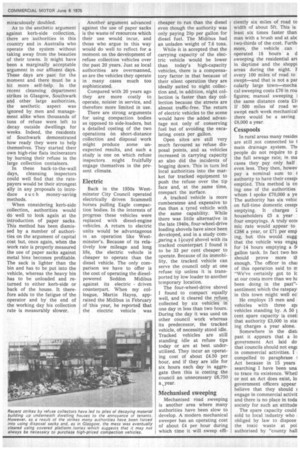Why waste money?
Page 53

Page 54

Page 55

If you've noticed an error in this article please click here to report it so we can fix it.
WHEN the jargon of the economists and the platitudes of the politicians concerning Britain's economic ills are analysed, the clear message is that for the past 20 years we have not been working hard enough. Overmanning is endemic throughout British industry, and in this context, public utilities and local government departments are included.
A full generation of management and labour has been developed in this overmanned atmosphere; the development of a second generation is far advanced. The root cause of the trouble can be traced to what appears to be a laudable principle of the Attlee Government—full employment. Because although this meant no unemployment, it has since meant underemployment.
The largest factor in operating or production costs is the wage or salary element—a fact recognised by politicians, trade unionists and employers. Yet when savings are called for, attention is not directed to the labour force but to the plant, machinery and vehicles they operate. The working life of the equipment is stretched beyond its economic life because it has the politically desirable effect of showing an immediate saving on capital expenditure. That it creates increased revenue expenditure through additional repair and maintenance 6osts is ignored, and what mi4ht at first sight appear to be a saving in the long run reMllts in higher expenditure,tich in the case of local gove nment leads to ever-increasing rate demands.
Plagued
The lives of local government officers have been plagued for years by the demands of their council masters to stretch machinery beyond its economic life and preserve jobs at an costs. Indeed, when Mr Anthony Crosland, Secretary of State, DoE, told them last month that the party was finished, they could have been excused if they had thought he was referring to the demise of their political bosses. " We could not believe that he thought we had been on a financial extravaganza for years," I was told by one longserving cleansing inspector. The Government's latest clamp-down on public spending has meant halving the capital expenditure planned by many authorities, particularly on vehicle replacement. The fact that the officers had already given their professional opinion that repair would cost more than replacement seemed to concern no one.
Professionals
Almost all the local government officers to whom I spoke agreed that they could have effected greater savings in other directions. "But how can we apply these methods if they mean either a poorer service to the ratepayers, or redundancies?" I was asked. "The council would never stand for it."
Local government officers have never had a better opportunity to display their corn mercial skills than they n have—a few may expose lack of them. For so long rnz of them have been under influence of their part-ti political masters that V now lack the courage to like professionals.
"We know what must done," said one, "but h can we tell them?" " Perhap he went on, "CM could do : Understandably, none of officers to whom I sp( wished their or their auth( ties' names to be divulged. I with few exceptions, mi the same pattern of events be found throughout the wh of local government operati I confined my inquiries four aspects of local gove rnent activity : centrali transport; refuse collection disposal; street sweepi sewage collection.
Since the reorganisation local government boundat • hich took place in England id Wales last year and in cotland this year, the apartments of a number of Athorities have been merged rider one larger authority. ievitably, there has been verlapping and since most Lthorities carried spare men id vehicles the overmanning ;pea has been enlarged. In .1 but a few authorities, the ansport-using departments -e still responsible for their wn day-to-day operation so ?at the overmanning will mitinue. For many the only :tempt at centralising transprt has been to make the eansing inspector responsible n. the organisation of the ?pair and maintenance of the )uncil's vehicles; he has no irisdiction for their operation. The result of this means that art-loaded vehicles for two r more departments can be iund working in the same rea of a town at the same me. Some tipping vehicles, I learned, were running less than 10 miles per day. "We are employing motor vehicles on horse-drawn systems," was how one officer saw the position. He believed that this alone accounted for about 10 per cent excess labour.
On the function of refuse collection, it appears that in most areas too many men and vehicles are collecting too little refuse, There are so many collection systems, types of manning and models of vehicles in existence, sometimes working within the same authority, that no clear pattern emerges and yet the purpose of the operation is of itself basically simple—to dispose of waste material.
I spoke to one officer who had been told by his authority to cancel orders for new vehicles in order to save £80,000. This authority uses a number of vehicles for 40 hours each week clearing refuse from high-rise flats. The vehicles with crews cost a minimum of £10 per hour to operate. If only four vehicles were taken out of service the authority would save £1,600 per week or £83,200 per year. This would then leave the problem of disposing of the refuse, which I understand could be catered for by the• construction of a simple incinerator at each of the highrise flat complexes which would be operated by the janitor. Its construction and operation would not cost any thing like the £83,000 a year which it would save. There is, of course, the further problem of the 16 redundancies which the council would have to meet, but this is where real savings can be found.
Kerb-side collection
Refuse collection from terraced houses is a more expensive operation than it is from one-lift high-rise flats and here again a change in the method of operation of many authorities would show worthwhile savings. One South of England refuse inspector to whom I spoke was appalled at my suggestion that he should revert from back-of-the-house to kerb-side collection. "The ratepayers would never stand for it," he said.
"If they were told that it might save the town £200,000 per year they might just stand for it," I suggested, He did not answer. Even the "aesthetically undesirable " argument would look weak in the face of such a saving.
Whereas at the moment his authority engages 25 vehicles and 125 men it could, by changing to kerb-side collection, do the same job with 15 vehicles and 75 men including drivers. The 10 vehicles which they would save carry five-man crews and cost about £15 per hour to run, or £150 per hour in total. Based on a 40-hour week and a 50-week year their withdrawal would show a gross saving of £300,000.
To achieve this saving the work rate per man would have to be stepped up. The present work rate is 50 dwellings per man hour. By asking the householder to place his refuse bin or sack at the edge of the kerb this figure could be raised to 65 dwellings per hour. Because the collector does not spend time walking to the back of the house and back again to the vehicle he not only conserves time, but so also does he conserve energy.
Arguments that work rates cannot be increased have been largely destroyed in the past with the introduction of bonus systems. The implementation of bonus systems invariably produces more time, energy and effort.
Many local authorities operate a "job and finish" system. Under this method the crews are given a set number of collections to make each day and when they have been made the rest of the time is their own. In the case of one authority to whom I spoke, 1 was told: "The men seldom work an eight-hour day except after public holidays."
The inspector agreed that even under the present system the rate could be further speeded up, but he visualised difficulties with the trade unions. 1 found from experience when men were working a "job and finish" system and there was a local midweek afternoon sporting fixture that the collection rate could be miraculously doubled.
As to the aesthetic argument against kerb-side collection, there are authorities in this country and in Australia who operate the system without taking away from the beauties of their towns. It might have been a marginally acceptable argument in our affluent days. These days are past for the moment and there must be a bit more self-help. In the recent cleansing department strikes in Glasgow, Southwark and other large authorities, the aesthetic aspect was ignored by men and management alike when thousands of tons of refuse were left to decay outside dwellings for weeks. Indeed, the residents of Southwark demonstrated how ready they were to help themselves. They started their own high-rise flats incinerators by burning their refuse in the large collection containers.
In these back-to-the-wall days, cleansing inspectors could well find that the ratepayers would be their strongest ally in any proposals to introduce such money-saving methods.
When considering kerb-side collection, authorities would do well to look again at the introduction of paper sacks. This method has been dismissed by a number of authorities on the argument of capital cost but, once again, when the work rate is properly measured the use of paper sacks against metal bins becomes profitable. The sack is lighter than the bin and has to be put into the vehicle, whereas the heavy bin has to be unloaded and returned to either kerb-side or back of the house. It therefore adds to the fatigue of the operator and by the end of the working day his collection rate is measurably slower. Another argument advanced against the use of paper sacks is the waste of resources which their use would incur, and thOse who argue in this way woUld do well to reflect for a moinent on the development of refuse collection vehicles over the past 20 years. Just as local authorities are overmanned, so re the vehicles they operate in J many cases much too sophisticated.
compared with 20 years ago thy are more costly to op rate, noisier in service, and th efore more limited in use.
There are strong arguments for using compaction bodies as opposed to side-loaders, but a detailed costing of the two operations on short-distance collection and disposal work might produce some unexpected results, and such a study is one on which refuse insPectors might fruitfully engage themselves in the present climate.
Electric
pack in the 1950s Westmister City Council operated ele trically driven Scammell ho ses pulling Eagle compaction bodies. In the interests of progress these vehicles were replaced with diesel-engine vehicles. A return to electric units would be advantageous in an operation like Westminster's. Because of its relatively low mileage and long life, the electric vehicle is cheaper to operate than the diesel vehicle. The only comparison we have to offer is the cost of operating the dieselpowered Seddon Midibus against its electric driven counterpart. When my colleague, Martin Hayes, appraised the Midibus in February of this year, he reported that the electric vehicle was cheaper to run than the diesel even though the authority was only paying 29p per gallon for diesel fuel. The Midibus had an unladen weight of 7.6 tons.
While it is accepted that the carrying capacity of the electric vehicle would be lower than today's high-capacity vehicles, there is a compensatory factor in that because of their silent operation they are ideally suited to night collection and, in addition, night collection is faster than day collection because the streets are almost traffic-free. The return of electric vehicles to the scene would have the added advantage not only of conserving fuel but of avoiding the escalating costs per gallon.
Open sites are still very much favoured as refuse disposal points, and as vehicles increased in carrying capacity so also did the incidents of bogging down. This in turn led local authorities into the market for tracked equipment to push the refuse over the tip face and, at the same time, compact the surface.
A tracked vehicle is more cumbersome and expensive to run than a tyred vehicle with the same capability. While there was little alternative in the late 1940s, four-wheel-drive loading shovels have since been developed, and in a study comparing a llcuyd shovel with its tracked counterpart I found it to be 33 per cent cheaper to operate. Because of its immobility, the tracked vehicle can serve the council only at one refuse tip unless it is transported by low loader to another temporary location.
The four-wheel-drive shovel I found to compact equally well, and it cleared the refuse collected by six vehicles in one day in less than two hours. During the day it was used on other council work whereas its predecessor, the tracked vehicle, of necessity stood idle. Tracked vehicles are still standing idle at refuse tips today or are at best underutilised. They incur an operating cost of about £4.50 per hour, and if they are idle for six hours each day in aggregate then this is costing the council an unnecessary £6,750 a s year.
Mechanised sweeping
Mechanised road sweeping is another area where many authorities have been slow to develop. A modern mechanical sweeper has an operating cost of about £4 per hour during which time it will sweep effi ciently six miles of road to width of about 5ft. This is least six times faster than man with a brush and at abc two-thirds of the cost. Furth, more, the vehicle can operated 18 hours a d sweeping the residential arE in daytime and the shoppi areas during the night. F every 100 miles of road to swept—and that is not a par cularly large town—mecha cal sweeping costs £70 in rou figures; manual sweeping the same distance costs £11 If 500 miles of road wi swept each week mechanical there would be a saving £8,000 a year.
Cesspools
In rural areas many reside, are still not connected to 1 main drainage system. Tiu people do not require to p the full sewage rate; in ma cases they pay only half even less. They then, howev pay a nominal sum to 1 authority to have their cessp4 emptied. This method is co ing one of the authorities whom I spoke £70,000 a ye The authority has six vehic on full-time domestic cesspt emptying. It charges 2 householders £5 a year four emptyings. A truly ecoi mic rate would appear to £286 a year, or £71 per emp ing, but this would sugg that the vehicle was engq for 14 hours emptying a 51 gallon tank. In fact two hoi should prove more tI enough. The officer in chai of this operation said to rn "We've certainly got to lc at our costs more than we 1.1t• been doing in the past"sentiment which the ratepay in this town might well ecl He employs 15 men and vehicles with three spi vehicles standing by. A 50 cent spare capacity is costi that authority £3,000 in stai ing charges a year alone.
Somewhere in the dist; past it appears that a lo government Act laid do. that councils should not engE. in commercial activities. I . compelled to paraphrase 1 Act because in 15 years searching I have been una to trace its existence. Whet] or not an Act does exist, lo government officers appear believe that they should i engage in commercial activit and there is no place in toda society for such an attitude The spare capacity could sold to local industry who . obliged by law to dispose the toxic waste at poi authorised by "county hall


















































































































